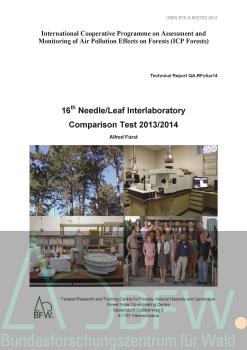- Standardsignatur15015
- Titel16th Needle/Leaf Interlaboratory Comparison Test 2013/2014
- Verfasser
- ErscheinungsortWien
- Verlag
- Erscheinungsjahr2014
- Seiten48 S. + Annex-Results
- MaterialMonographie
- ISBN978-3-902762-28-3
- Digitales Dokument
- Datensatznummer180196
- QuelleNeedle/Leaf Interlaboratory Comparison Test : Further Development and implementation of an EU-Level Forest Monitoring System - Futmon - : Technical Report LIFE+ QA-RFoliar10 in Cooperation with the International Cooperative Programme on Assessment and Monitoring of Air Pollution Effects on Forests (ICP Forests), 48 S. + Annex-Results
Technical Report QA-RFolia, 48 S. + Annex-Results - Abstract56 laboratories in 25 countries participated in the 16th Needle/Leaf Interlaboratory Test. A new system for qualification and re ]qualification started with the 11th test in 2009. This system was enlarged after the manual update in 2010 to all ICP ]Forests partners (see Konig et al. 2010, 2013, Rautio et al. 2010, 2013 Pitman et al. 2010). With the ring test report each participant get a qualification report, the download is possible on the webpage (http://bfw.ac.at/ws/ring_nadel.login). It has been decided to qualify the results of each parameter separately. If 50% or more (generally two, three or all four samples) of the results for this parameter for all the samples of the ring test are within the tolerable limits, the laboratory is qualified. Re ]qualification is mandatory for all ICP ]Forests laboratories, if monitoring results (foliage, litterfall, ground vegetation) will be submitted to PCC in autumn 2014 from the vegetation period 2013. New since the 14th Interlaboratory Test is the usage of maximum acceptable limits of quantification (LOQ). These limits are needed, because a lot of laboratories are using multi element methods (mostly ICP ]AES) with higher LOQs for some elements. But for evaluating and classification of the monitoring samples real measured results and lower LOQ are needed. A task was given from the 12th Expert Panel Meeting Foliage and Litterfall (Tallinn 2011) to the Working Group QA/QC in Laboratories to fix this problem. Maximum acceptable LOQs for mandatory and optional parameters for foliage, litterfall and ground vegetation were discussed and accepted in the 3rd Lab ]Head Meeting (Arcachon 2011). This problem is fixed now . no laboratory submits higher LOQs than the maximum acceptable. In case of very low concentrations of copper, cadmium and lead in the interlaboratory comparison test samples, these results will be excluded from the evaluation (this happened for the lead results of the samples 1 and 4 and for the cadmium results of the samples 2 and 3). This procedure is needed to avoid wrong qualification results influenced by inaccurate measurements ] and on the other hand there is no real need to detect these very low concentrations in real monitoring samples, because it gives no additional information of the nutrient status or of the pollution impact situation.
- SchlagwörterNadelanalyse, Blattanalyse, Luftverschmutzung, Vergleichsanalyse, Vergleichsmethode, Monitoringprogramm, Labordaten, Laboruntersuchung, europäischer Vergleich, Erhebungsverfahren, Stickstoff, Schwefel, Phosphor, Calcium, Magnesium, Kalium, Zink, Mangan, Eisen, Kupfer, Blei, Cadmium, Bor, Kohlenstoff
- Klassifikation
| Exemplarnummer | Signatur | Leihkategorie | Filiale | Leihstatus |
|---|---|---|---|---|
| 1432304 | 15015 | elektronische Publikation | Verfügbar |

Hierarchie-Browser


